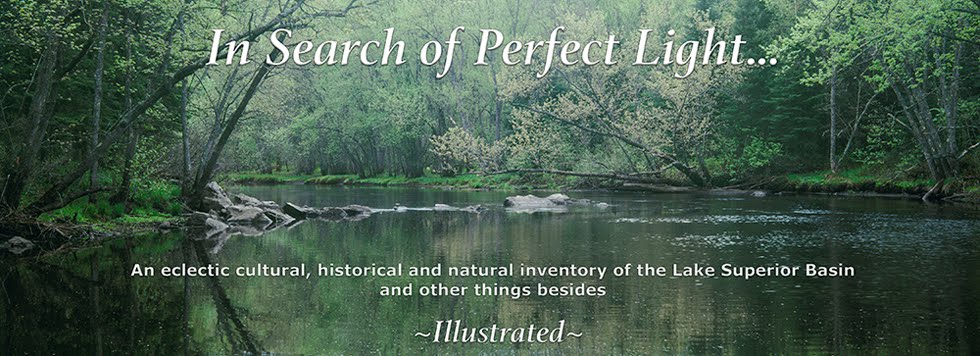Though coincidentally home to porcupines, when viewed from the east this
range of ancient mountains resembles a crouched Kag, or Porcupine. That's why they were called Kag wadjiw by the Ojibwa. The name stuck.
Due to years of citizen advocacy, this magnificent place was first secured
as a park in 1945. With further protections since gained, the Porcupine Mountains Wilderness became the
crown jewel of the Michigan State Parks system and today ranks among the finest
relatively undisturbed landscapes on the Superior Basin. At its heart stands
nearly 35,000 acres of virgin northern hardwood forest, said to be the largest
such tract to remain in North America.
From a 4x5 transparency
After near to twelve hours on the road and well past dark, on the first
night of our first trip together to Superior, Heather and I arrived at the Presque
Isle campground that marks the western end of the Porkies. We set up camp and devoured
a stack of hastily prepared Bisquick pancakes slathered with rich currant jelly made
by Heather's dad. Then we fell asleep to the whisper a big lake offers at its
shore.
The next morning brought our first Northwoods lesson: leave a plastic
jug of dough on the picnic table overnight and you'll later clean up after
a critter ambles along and savages the jug for to get at the bounty of tasty
goo while you're otherwise oblivious.
That morning also revealed that we'd pitched our tent at the forested edge
of a high bluff looking roughly west out over Superior, so it was all good.
Heather, from a vintage 35mm negative
Our relationship with the place now stretches near to 40 years and is
indelibly personal.
In the Porkies Johnny, Heather and I bushwhacked over the hills searching
for evidence of Copper Complex people,
to no avail. Likewise our always half-hearted hunt for the crashed B-17, artifacts of which can be found
in collections scattered throughout the region.
We didn't actually look for
the legendary pictographs as told to Henry Schoolcraft by the Ojibwa shaman Chingwauk, but always hoped
we'd somehow find them anyway. To date, no one has.
Me & Johnny, from a vintage 35mm negative taken by Heather
It was on the South Boundary Road at dusk where we encountered our
first wild wolf, many years before those were properly reestablished and long
before one could even imagine we'd be engaged in civic conversation about
hunting wolves, as we are again today.
This particular wolf instead worried over road kill just off the
shoulder of the road.
We slowed and pulled alongside.
The wolf lifted its formidable head to address us with the most
sentient eyes I've ever seen. In them could be found no sign of fear or
aggression, though they fairly shone with a remarkable awareness and make no
mistake.
In response, Heather rolled up her window.
After a while the great beast took a step back and drew itself in to
the darkening wood. We left the wolf to its meal and returned to camp
exhilarated.
I've not again been so close to a wild wolf until last autumn, during
this Odyssey. To be sure it was under entirely different circumstance but again
at the side of a road, which is an unhappy story for another time.
Heather and I spent half our honeymoon at the Presque Isle. On my 2nd
night of marriage I managed to bounce a thankfully dull axe off the back of my
hand. Heather fixed me then and there and our template for wedded bliss was
set.
Of all the fish I've ever tussled with, by far the finest of 'em swam
the Presque Isle.
Heather fishing the mouth of the Presque Isle, from a vintage 4x5
I once fought a fish upriver and down for more than forty minutes,
tethered to only 6# test. Finally I gained the upper hand. At last I brought
the behemoth to dark water at river's edge. In another moment, I'd need come to
grips with a monster from the deep.
Then with a sharp thwipt no
doubt heard all the way to Isle Royale, the line snapped. My knees shook while
I used my left hand to pry loose my right from the rod. The name of the beast
remains a mystery.
Then there was the time the biggest Steelhead I've ever seen rose from beneath my feet as I retrieved
a spinner through fast water while perched upon an undercut shelf. I swear she never
moved a muscle of her brightly colored flanks and became simply one with the current
so when that spinner reached just there
she was there too, to kiss it softly as it passed. And the fight was on.
For... I dunno, maybe three seconds. Seemed like forever then as now,
so amazing the sight and rich my memory of it.
Funny, how often fisher folk's greatest tales involve no fish at
all or the one that got away. Best leave that to ponder for people who don't
fish...
And did I mention that the South Boundary Road is my favorite drive anywhere? Miles of classic two lane
blacktop rolling up and down and all throughout the naturally indistinct
boundary between governmentally sanctioned wilderness and not.
The Porcupine Mountains Wilderness is wonderland. A complex, richly
rare landscape ideally suited to adventure and quiet contemplation in
turn and at your discretion.
It's for that and because I take the place so personally, that we'll
spend some bit of time there over the next few weeks...














